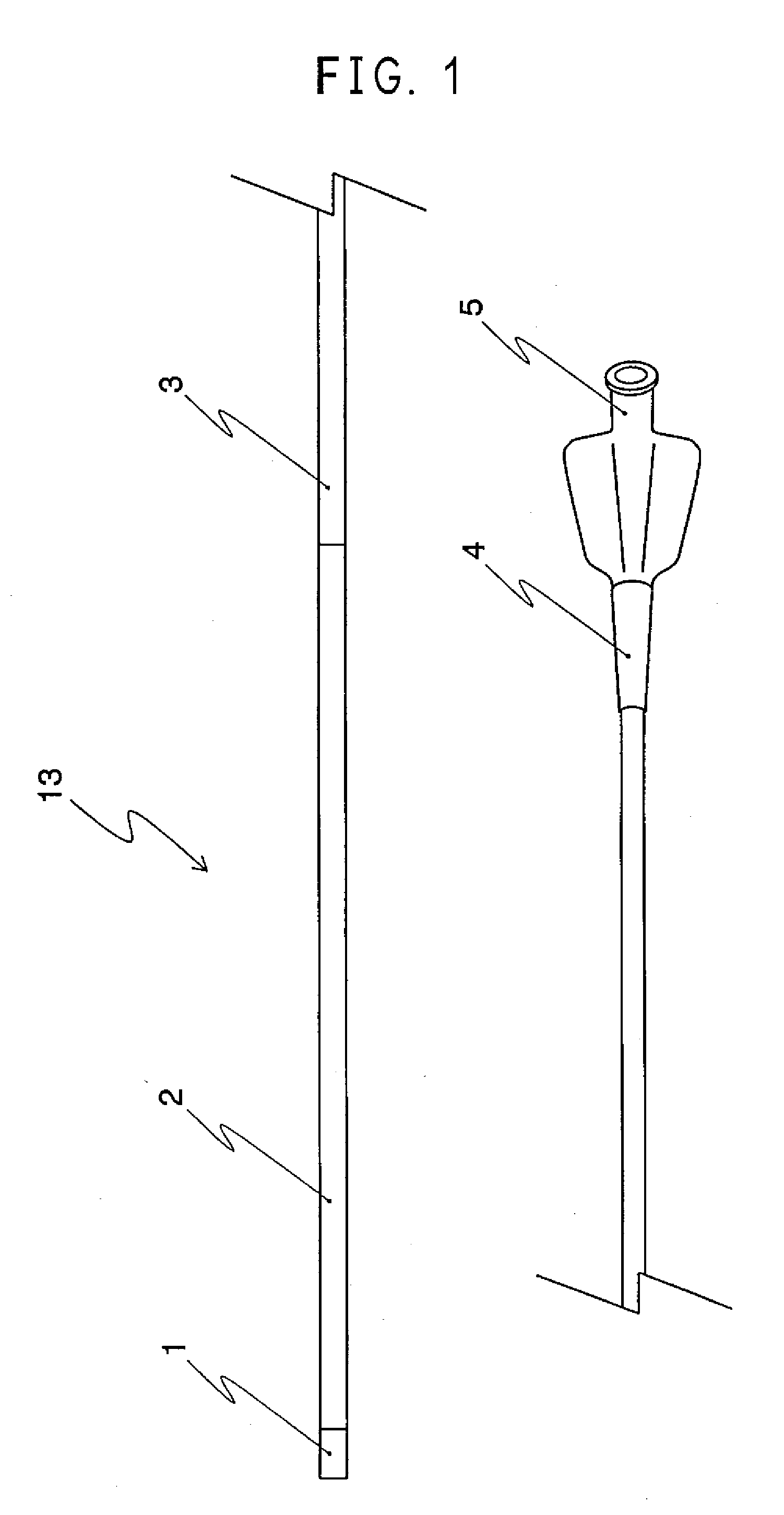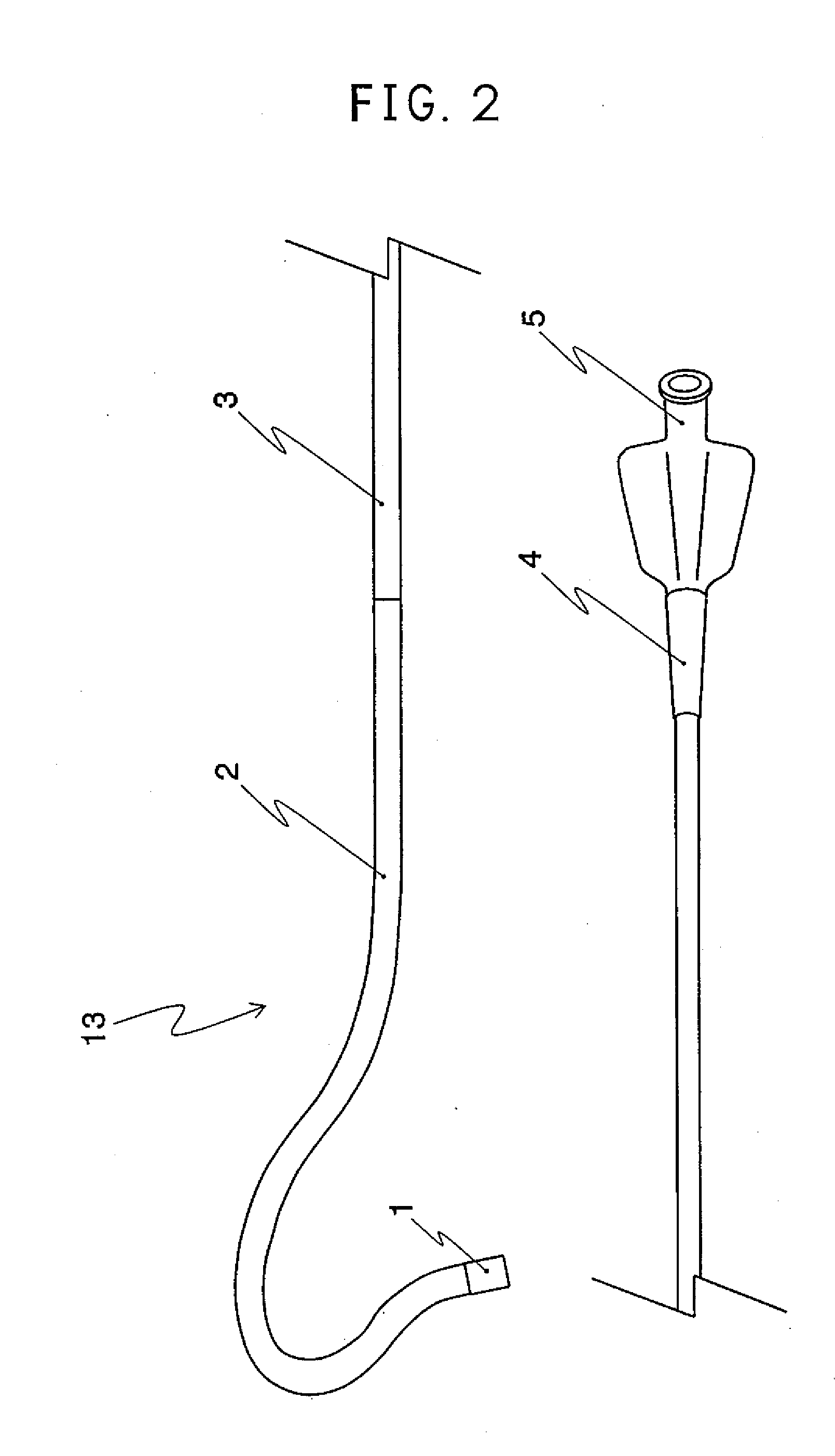Catheter
a catheter and catheter technology, applied in the field of catheters, can solve the problems of increasing the use amount of contrast medium, increasing the angiography cycle, increasing the number of catheters, etc., and achieve the effect of less introduction number of devices, efficient extraction, and same operability
- Summary
- Abstract
- Description
- Claims
- Application Information
AI Technical Summary
Benefits of technology
Problems solved by technology
Method used
Image
Examples
example 1
[0111]A braiding tube having an outer diameter of 2.05 mm, an inner diameter of 1.85 mm and a length of 900 mm was prepared using a braiding metal that was obtained by processing a metal wire with 0.10 mm×0.03 mm prepared from SUS 304 alloy by one holding and 16 hits. An inner layer was prepared using a polytetrafluoroethylene (POLYFRON F-207; Daikin Industries Ltd.) and an outer layer was prepared by a switching extrusion process using 4 kinds of polyamide elastomers (PEBAX7233SA01 (Shore hardness of 72 D), PEBAX6333SA01 (Shore hardness of 63 D), PEBAX5533SA01 (Shore hardness of 55 D) and PEBAX4033SA01 (Shore hardness of 40 D); Elf Atochem Inc.).
[0112]A tube having an outer diameter of 3.00 mm, an inner diameter of 2.25 mm and a length of 150 mm was prepared using a polyamide elastomer (PEBAX4033SA01 (Shore hardness of 40 D); Elf Atochem Co.) by an extrusion molding. A core material having an outer diameter of 2.20 mm made of SUS304 alloy that was preliminarily shaped was inserted ...
example 2
[0115]A braiding tube was prepared in like manner as Example 1 except an outer diameter of 2.95 mm and an inner diameter of 2.75 mm.
[0116]A tube made of a resin was prepared in like manner as Example 1 except that a tube was prepared using a polyamide elastomer (PEBAX3533SA01 (Shore hardness of 35 D); Elf Atochem Inc.) and two side holes with a diameter of 2.10 mm were provided using excimer laser. The phase difference of the side holes was 180° and distance between the side holes to a length direction was 40 mm. A catheter for extraction was prepared in like manner as Example 1 using the braiding tube and the tube made of a resin obtained.
[0117]A tube made of resin having an outer diameter of 2.20 mm, an inner diameter of 1.90 mm and a length of 1050 mm was prepared using a low density polyethylene (LF480M, Japan Polychem Corporation) by extrusion molding and a hub prepared with a polycarbonate (Makloron 2658; Bayer AG) was glued at one end with a two liquid mixing type urethane ad...
example 3
[0119]A braiding tube was prepared in like manner as Example 1 except an outer diameter of 2.40 mm and an inner diameter of 2.20 mm. A tube made of a resin was prepared in like manner as Example 1 except that a tube was prepared using a polyamide elastomer (PEBAX5533SA01 (Shore hardness of 55 D); Elf Atochem Inc.) and two side holes with a diameter of 1.85 mm were provided using excimer laser. The phase difference of the side holes was 180° and distance between the side holes to a length direction was 40 mm. A catheter for extraction was prepared in like manner as Example 1 using the braiding tube and the tube made of a resin obtained.
[0120]A subcatheter was prepared in like manner as Example 2 except an outer diameter of 1.80 mm and an inner diameter of 1.50 mm.
[0121]D1 in Example 3 is 2.20 mm and D3 is 1.85 mm.
PUM
 Login to View More
Login to View More Abstract
Description
Claims
Application Information
 Login to View More
Login to View More - R&D
- Intellectual Property
- Life Sciences
- Materials
- Tech Scout
- Unparalleled Data Quality
- Higher Quality Content
- 60% Fewer Hallucinations
Browse by: Latest US Patents, China's latest patents, Technical Efficacy Thesaurus, Application Domain, Technology Topic, Popular Technical Reports.
© 2025 PatSnap. All rights reserved.Legal|Privacy policy|Modern Slavery Act Transparency Statement|Sitemap|About US| Contact US: help@patsnap.com



